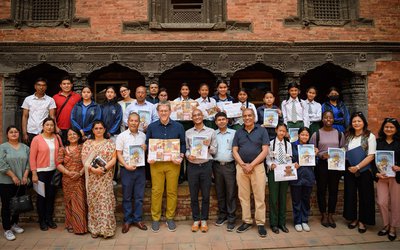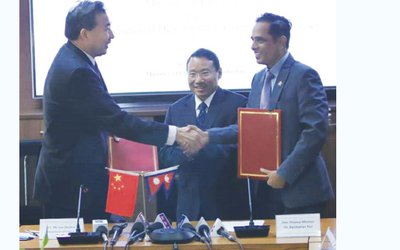Nepal is largely a rural country richly endowed with Agro bio-diversity. Small holder and marginal farmers constitute a majority of population. Farming is a family enterprise and forms the basis of rural economy. It continues to offer food, employment and livelihoods to a large portion of people, yet the contribution of the agricultural sector to GDP is relatively low, thus making those working in that sector relatively poorer. Moreover, despite engagement of 67% population in agriculture sector, Nepal has a huge trade deficit in Agro -food products.
In the absence of alternate income from non-farm jobs, majority of youths, ironically, are opting to go abroad for employment deserting the villages in the hope of decent living in future. If the rural economy had more jobs, together with economic and social infrastructures and better prospect for business, the youth would have stayed in the village of their own. Shortage of Agro -based industries or other viable micro, small and medium enterprises (MSMEs) in the villages is another reason for the dismal job scenario in the rural sector. The employment situation has therefore to be improved in rural areas in order to prevent the youth human assets of the country from going abroad to build nations other than their own. Balanced economic growth, inclusive and sustainable development and the reduction of poverty specifically in rural parts are obviously significant challenges. The challenge of eliminating rural poverty and un/under employment will be further heightened by rapid growth of the workforce in the country. Adding to the woes, the villages are likely to be flocked with unemployed youth when Nepali migrant workers return back to their home once the sky opens a after the storm of Covid-19 will lessen over time. So, considering seriously the likely worsening rural economic scenario, the government has to design implementable policies and plans without making delay.
The rural economy holds considerable potential for economic growth, employment creation and promotion of decent work if the right policies are in place. Rural area is a mixture of both on and off farm activities ranging from small holder agriculture or pastoralism to highly sophisticated commercial agri-business supplying global markets through intense regional and national linkages with industrial and service sectors.
Viewing that rural area has tremendous untapped potentials, the government should have clear conception of what the rural sector is likely to look like 10-20 years into the future given that efficient use of locally available resources is made. Studies have indicated that 1% growth in agriculture is 2-3 times more effective in poverty reduction compared with the similar growth in other sectors of the economy. Following the study, focus should be placed on sustainable agriculture development with high agricultural productivity for poverty reduction, employment generation and income enhancement of rural people. The problems facing the small holder farmers must come at the forefront to be addressed at the earliest. In order to enhance agricultural production in the short run, small holder farmers need to be assured of uninterrupted inputs supply along with the reliable support of extension workers. Access to land in lease/rent for the landless, subsidized inputs and affordable credit, appropriate technology, information, market assurance of produce etc. may be the stimulus for the small farmers to scale up their production level. In addition, further measures to enhance production and productivity could be aggregation of small plots of land through incentivization, mechanization, innovation, research followed by extension of technology and knowledge, access to affordable credit, strengthening of farmers’ agriculture co-ops, establishment of farmers business schools in local levels, ICT, farmers market in urban centers, guarantee of minimum support price, availability of warehousing and cold storage etc. Development of entrepreneurship thinking of farmers, spending more on the agriculture sector, investment in infrastructure, attraction of educated youth in agriculture with proper incentives, use of fallow lands for agriculture, connecting farmers to markets etc. could help stimulate agricultural production. South Korea started as an agriculture-based economy in the 1960s and it became the 11th largest economy in the world in terms of GDP in 2016.The only important thing required is readiness of those at the helm to transform the agriculture sector. Based on the ecological zones, some areas of the country can be selected for cereal crops production and some for crops with higher comparative advantage and higher marketability and growing them on a commercial basis for both domestic and international market.
Nepal offers a huge possibility of turning agriculture into commercial venture and starting industrial activities. Successful rural economic transformation depends on a combination of agricultural upgrading and development of non-farm economies, maximizing the synergies between the two. In Ethiopia, the government adopted a new development strategy called Agricultural Development-Led Industrialization (ADLI) aiming to stimulate farm output and rural incomes. Agriculture production and productivity in Vietnam’s growth facilitated industrial development and was a major factor in downing rural poverty.
Time has now come to focus on increasing value addition and processing agricultural products. Instead of providing the raw materials to other nations, Nepal has to process/manufacture the products itself. Agro based industries are comparatively easy to establish and provide income in the rural areas with less investment. Agriculture SMEs facilitate effective and efficient utilization of local agricultural raw materials. They can be setup on cooperative basis ensuring full participation of the people in the development process which ensure balanced and equitable growth. Nevertheless, Access to timely, affordable and appropriate type of finance and consistent access to stable and high value markets remain the most daunting challenges faced by SMEs in agriculture. There is a need of SME incubation centers at least one in each province to support promotion of Agriculture SMEs. SME financing gap as estimated by the study of Sakshyam Access to finance (2017) is1.2 billion US Dollar, which is required to be fulfilled for smooth operation of SMEs.
In order to revive rural economy, the concept of PURA (providing urban amenities to rural areas) that the former Indian president Abdul Kalam promoted to revive India’s rural economy and development is equally relevant in Nepal’s case too. The logic behind the concept of PURA is sound because it would also help in creating other non-farm opportunities in rural areas that could augment farm income as well as employment, thus encouraging the youth to stay in rural areas. In Nepal’s case, that new opportunity could be ‘rural tourism’ because rural areas contain attractive landscapes with scenic beauty, cultural heritage clean environments and food with unique taste and aroma. The PURA approach will surely help accelerate this enterprise and revive the rural economy We can also learn from Italy’s policy of reviving smallholder agriculture through agricultural tourism (Agri-tourism, or ‘farm-stays’) in the Tuscany region.
Given that Nepalese rural economy has witnessed poverty and unemployment since long, the Small Farmer Development Financial Institution(SKBBL) together with its owner partner cooperatives known as Small Farmer Agriculture Cooperatives(SFACL) has been effortful to contribute towards poverty reduction and employment creation in villages through extending both financial and human capital development support to low income populace especially small holder/marginal farmers of the country. Additionally, SKBBL with the conviction that educated youth alone can transform the agriculture sector; it has managed to send around 3,200 youths to Israel’s agriculture training colleges to learn modern agriculture technologies with the generous support of Israel government. It is estimated that around 40 percent of the returnees are doing commercial agriculture at least doubling the agricultural productivity. It is further heartening to know that small holder farmer members and Israel returnee youths of a few cooperatives have started collective farming either in their own land or purchased/leased land showcasing the examples of commercialization and diversification of agriculture. Rural tourism initiation of a few co-ops can also be seen mainly in eastern rural parts of the country. Agro-based Small and Medium Industries (SMIs) likewise operated by small farmer entrepreneurs or by the co-ops themselves can be observed many more in various locations of countryside.
To sum up, the SKBBL and and its partner coops have played the role of catalyst to boost the rural economy through poverty reduction, employment generation for youth and income enhancement of deprived rural communities. Both the SKBBL and the SFACL look forward the constant support of its stakeholders in materializing their dream of wiping out poverty and unemployment in rural areas and boost the rural economy thereby strengthening the national economy of the country.
















